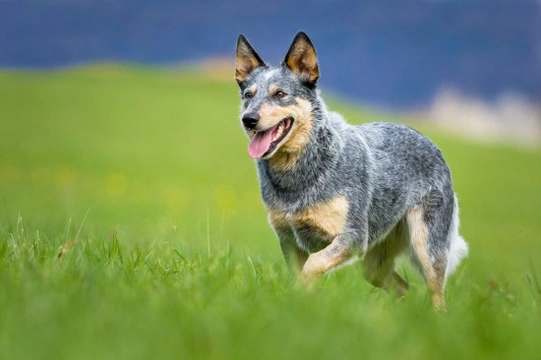
Heeler or Australian cattle dog traits and temperament
The Heeler (red or blue) also sometimes known as the Australian cattle dog is a highly intelligent, lively and active working dog breed that shares a reasonable amount in common with the Border Collie. Originally bred to assist with herding cattle in the harsh environments of the Australian outback, the heeler is a bold, headstrong and independent dog that is perfectly fit to go out and work all day if needed!
Their name originates from their working skill of cattle droving by nipping at the heels of the beasts, rather than as is sometimes assumed, because of a great proficiency to walk to heel!
The Heeler is one breed that can prove infinitely rewarding to own for the switched on, active and experienced dog owner, particularly those who are interested in taking up a canine sport or simply spending lots of time out of doors with their dog. However, like the Border Collie, the Heeler can be a right handful in the wrong hands or with poor training and management, and so ensuring that you are fit for the challenge of owning one should be your first consideration!
In this article, we will look at some of the core traits of the Heeler’s temperament and care requirements, to help you to decide if they might be a good fit for you. Read on to learn more!
Heeler history and origins
When British citizens and other European residents emigrated to Australia in the 1800’s, they took several different working dog breeds with them to help them to work the land and control their stock. Over time, imported breeds such as the Dalmatian, bull terrier and collies were cross-bred with the native dingo to produce a dog that was well suited to tackle the challenges of the terrain and their new working roles, and so the Heeler was born.
The Heeler should be muscular and compact, standing at around 17-20” tall at the shoulder and weighing up to 35lb. Heeler puppies are all born pure white, and develop their red or blue colouring once they reach a few weeks old, much as the Dalmatian (one of their ancestral breeds) do not get their spots until a while after birth.
The traits and core characteristics of the Heeler
The Heeler was first and foremost designed to be a supremely fit, hardy outdoors dog that would be able to work long days without exhausting. They are hardy, wiry and very active, and were never intended to be indoor dogs or family pets! However, the nature of their working roles meant that they would build up a very strong relationship with their handlers, and bond closely with their owners, who would often work outside with them for several weeks at a time.
The Heeler can be a challenge to keep as a pet within suburbia, and in order to own one domestically and keep it happy, you will need to dedicate plenty of time to fulfilling all of their needs. If you live a fairly sedentary lifestyle and do not like walking and going out in all weathers, the Heeler would not be a good choice of dog for you!
They have strong working and herding instincts, and as such require a suitable outlet for these energies, as well as strong, experienced training and handling to keep them from becoming unruly.
If you like to spend a lot of time outside working, walking or hiking and can take your dog with you, or enjoy taking part in canine sports such as agility however, the Heeler might be a good choice.
Is a Heeler the right dog for you?
It is important to think long and hard about the potential challenges that can come with owning a Heeler, and not to simply fall for the charms of a cute, lively puppy and then find out that you are not capable of managing them as they grow up!
If you have ever owned a Border Collie or another dog of an active, lively herding breed, you will already have a head start on coming to understand the temperament and traits of the Heeler, but if not, you should make an effort to spend lots of time around dogs of the breed before you commit to a purchase!
Heelers are generally very tenacious, independent and able to concentrate and work closely on one task for a prolonged period of time, but they are also fun loving, outgoing and friendly dogs that love the company of people, and if you have active children, they will soon become close companions.
However, unless you live on a farm, in a rural area, or are able to make your dog one of, if not your main priority, then you might find that you are unable to take care of a Heeler properly or keep them fit, happy and stimulated.



